Precision Hypoid Gearboxes
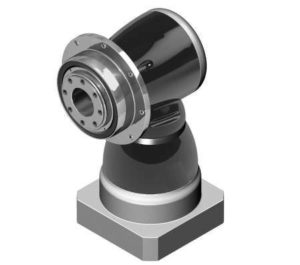
Quick Facts
- Extremely compact/short housing design
- 90° input via precision ground hypoid gears
- High precision, high torque, low noise
- Low backlash, ≤3 arc minutes
- Taper roller bearings allow high axial and radial loads
- Ratios from 3:1 up to 100:1
- Available in a number of different output configurations
- Fits most metric and NEMA servo motors
Product Overview
Candy’s Precision Hypoid Gearboxes have a 90 degree input thanks to precision ground hypoid gears. One of the key features of hypoid gearboxes is an extremely compact or short housing design. The CKH has a tapped rotary flange output and the CKF is available in four different output options.
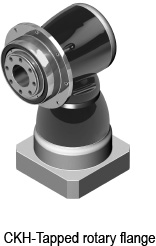
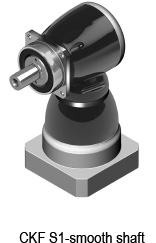
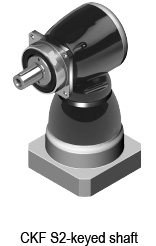
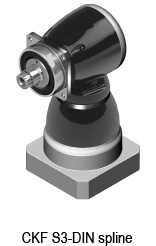
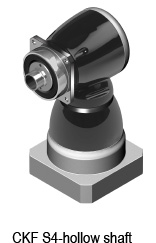
| SERIES | OUTPUT TORQUE | BACKLASH | RATIOS – 1-STAGE | RATIOS – 2-STAGE |
|---|---|---|---|---|
 CKH CKH
|
18 Nm – 1600 Nm | ≤3 arcmin | 3 / 4 / 5 / 7 / 10 | 12/16/20/25/28/35/40/50/70/100 |
 CKF CKF |
18 Nm – 1600 Nm | ≤3 arcmin | 3 / 4 / 5 / 7 / 10 | 12/16/20/25/28/35/40/50/70/100 |
DESIGN HIGHLIGHTS
HYPOID GEARS IN RIGHT ANGLE REDUCERS
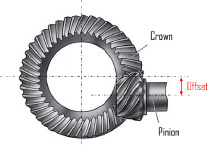
What is a hypoid gear?
A hypoid gear is a type of spiral bevel gear, generally used to transmit a rotational power between two shafts angled at 90°.
In contrast with bevel gears, the particularity of a hypoid gear set is that the mating gears’ shafts do not intersect. In other words, the small gear shaft (pinion) is offset from the larger gear shaft (crown). The axis offset allows the pinion to be larger and to have a greater spiral angle which increases the contact area and the tooth strength. Thus, more torque can be transmitted, and higher reduction ratios can be obtained.

Why would I choose a hypoid gear over a worm gear?
A hypoid can be viewed as an intermediate between a worm gear and a bevel gear.
For decades, worm gears were the popular choice for right angle reducers because they were robust and relatively inexpensive. Nowadays, hypoid gears are a better alternative on multiple levels. They have a better efficiency, especially at high reductions and low speeds. Hypoid gear sets are typically around 95% efficient, whereas worm gear sets can vary from 40% to 85% depending on the reduction ratio and speed. Therefore, a smaller motor can be used, which leads to an upfront cost reduction, and long term savings in electrical and maintenance costs. It also makes hypoid gear reducers more suited for space constrained applications.
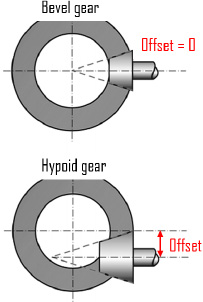
And over a bevel gear?
As said in the first paragraph, hypoid gears belong to the bevel gear family, usually divided in two categories: straight teeth and spiral teeth. While technically belonging to the latter, hypoid gears have enough specificities to be considered their own kind.
While sharing a similar shape, the main factor of differentiation between hypoid and bevel gears is the offset of the pinion. Inherently, the offset pinion allows freedom in the design of the user’s system. This offset also increases the pinion diameter and the contact ratio (average number of tooth pairs in contact typically 2.2:1 to 2.9:1 for hypoid gear sets). As a result, higher torque can be transmitted, and lower noise levels can be reached. However, hypoid gears are less efficient (90 to 95%) than a similar set of spiral bevel gearing (up to 99%), with efficiency decreasing as the offset increases. Special attention has to be given to lubrication due to the sliding action of the teeth to reduce friction, heat, and wear on the hypoid gears.
How does that translate into the choice of a reducer?
Single stage hypoid reducers can achieve reductions with a ratio of 3:1 to 10:1. In comparison
to straight or spiral bevel reducers, which need an additional planetary stage to achieve ratios
above 5:1.
Hypoid gears can be combined with planetary gears in multiple stage gearboxes to reach higher reduction ratios, typically up to 100:1 with additional planetary stages. In that case, hypoid gears should be chosen over bevel gears for the 90° angle transmission if the configuration of the system requires non intersecting shafts or if higher torques need to be transmitted in low noise levels.
Against worm reducers, hypoid reducers are a better option in terms of efficiency and heat generation. They require less maintenance and for the same amount of torque needed, hypoid reducers fit into tighter places. For long term cost savings, hypoid reducers are definitely an alternative to worm gear reducers that should be considered!
Why choose a hypoid reducer?
• Compact
• High reduction ratios
• Smooth and silent operation
• High precision and efficiency
 Candy Controls
Candy Controls